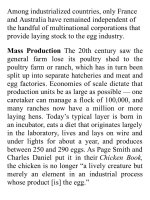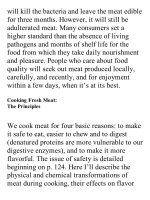On food and cooking the science and lore of the kitchen ( PDFDrive ) 129
Bạn đang xem bản rút gọn của tài liệu. Xem và tải ngay bản đầy đủ của tài liệu tại đây (211.76 KB, 2 trang )
Cool, Not Cold If cheese must be kept for
more than a few days, it’s usually easiest to
refrigerate it. Unfortunately, the ideal
conditionsforholdingcheese—ahumid55–
60ºF/12–15ºC, simply a continuation of its
ripening conditions — is warmer than most
refrigerators, and cooler and moister than
most rooms. Refrigeration essentially puts
cheese into suspended animation, so if you
wantanimmaturesoftcheesetoripenfurther,
you’llneedtokeepitwarmer.
Cheesesshouldneverbeserveddirect
fromtherefrigerator.Atsuchlow
temperaturesthemilkfatiscongealedandas
hardasrefrigeratedbutter,theprotein
networkunnaturallystiff,theflavor
moleculesimprisoned,andthecheesewill
seemrubberyandflavorless.Room
temperatureisbest,unlessit’ssowarm
(aboveabout80ºF/26ºC)thatthemilkfatwill
meltandsweatoutofthecheese.
CheeseCrystals
Cheeses usually have such a smooth,
luscioustexture,eitherfromthebeginning
orasahardcheesemeltsinthemouth,that
an occasional crunch comes as a surprise.
In fact a number of cheeses develop hard,
salt-like crystals of various kinds. The
whitecrystalsoftenvisibleagainsttheblue
mold of a Roquefort, or detectable in the
rind of a Camembert, are calcium
phosphate, deposited because the
Penicillium molds have made the cheese
lessacidandcalciumsaltslesssoluble.In
aged Cheddar there are often crystals of
calcium lactate, formed when ripening
bacteria convert the usual form of lactic
acid into its less soluble mirror (“D”)
image. In Parmesan, Gruyère, and aged
Gouda,thecrystalsmaybecalciumlactate
orelsetyrosine,anaminoacidproducedby
protein breakdown that has limited
solubilityintheselow-moisturecheeses.









